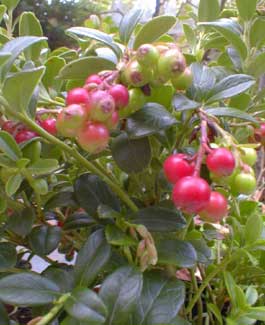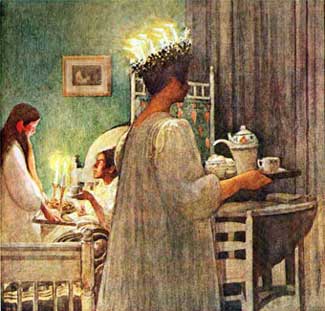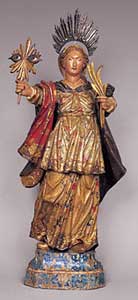
'Red Pearl'
Lingonberry
"And mother, find three berries red
And pluck them from the stalk,
And burn them at the first cockcrow
That my spirit may not walk."
-Elizabeth Eleanor Siddal
(1829-1862)
(1829-1862)
Vaccinium vitis-idaea var majus 'Red Pearl' is a Dutch cultivar, formerly called 'European Pearl.' Although a small evergreen, it is nevertheless taller than the majority of lingonberries, reaching sixteen inches in height. It can be a mite floppy in youth but eventually forms a wide mostly upright compactly leafed mound.
It's not impossible for 'Red Pearl' lingonberries to spread three feet wide, though it takes years, & a one-foot or eighteen inch spread would be more typical. They can demand some side-sheering if less space is apportioned to them. Some newer varieties like 'Balsgard.' are less inclined to produce young plants along rhizomes thus remain tidier & more compact individual shrubs, but older varieties like 'Red Pearl' or wild lingonberries more easily form a continuous groundcover.
It is one of the hardiest cultivars in a wider range of soil conditions than are tolerated by the German cultivar 'Koralle' or the Swedish 'Balsgard,' which are not as prone to rhizomitous spread. In locations that are occasionally droughty, including dryish shade, 'Red Pearl' would be the stronger choice for healthy foliage, even though no lingonberry fruits well if at all when planted in the shade.
Lingonberry does not require pruning but is amenable to it if it's necessary for size & appearance; they could even be hedged into miniature formal hedges. The young plants that erupt from the runners of 'Red Pearl' can be dug up to plant elsewhere or put in pots to trade with other gardeners.
The lingonberry patch at SinLur Gardens includes a mix of 'Red Pearl,' 'Koralle' & 'Balsgard.' Although lingonberries are self-fertile, fruit production both for size & quantity increases when multiple cultivars are planted together, & they ripen a week or two earlier.
'Red Pearl' has a reputation for producing somewhat fewer berries while expending more energy in rapid growth, though in fact in a sunny, moist location it produces quite well, though fruits are smaller than 'Koralle' & a lot smaller than 'Balsgard.'
Lingonberries' highest commercial use has been in Sweden, Finland, Norway & the Soviet Union, but they are becoming increasingly significant in harsh regions of Canada where it is too cold for many other berry crops. Most lingonberries sold as produce in grocery stores in the United States are imported from Canada.
Lingonberries are almost entirely disease free though "little leaf disease" causing stunted leaves & stunting or absence or flowers hence lack of fruit has been reported as an occasional problem in commercial fields in Scandinavia.
Winter mulching around the base of the shrubs is recommended further north, but here in Zone 8 these little shrubs are never even slightly at risk of winter injury. Even here, though, a light seasonal mulching with leaf mold, finely grated bark, peat, or composted manure will keep the acidity & organic component of the soil at the high margin lingberries need.
The first flowers of the season can be so early that late frosts stop them from fruiting, resulting in a smaller first crop, though on mild Puget Sound this is not a problem. The summer fruits tend to be more tart than autumn fruits. The second crop ripens in September, is usually the largest crop, & fully ripened autumn fruits will be sweeter after they've been through a couple of frosts.
The shrubs are hardy to Zone 3 in great part because they will be insulated under snow, & the berries will be preserved by natural refrigeration until spring thaw, providing the earliest fruit browse for animals coming out of hibernation. Fruits contain natural benzoate which is another reason why they are so long-lasting on the bushes, & upon harvest can be kept fresh a long while just by storing them in water or crushing them in their own juices, requiring no preservatives.
When young plants are first installed they usually produce fruits even their first year, but will take two years reaching their maximum productivity. If grown from seed they will likely be several years old before they begin fruiting.
I find them very tasty fresh & raw, but that's not their primary value to commerce or home use. They are usually cooked, sieved, & sweetened, & are used in juices, jellies & preserves, candies, wine, ice cream, wine & sometimes pickled. Dried as lingonberry raisens they are superb in muffins.
 Its species name vitis-idaea means "Vine of Mount Ida," or "Vine of Cybele" who as Great Mother of Mount Ida, Crete, bares the personal name Idaea, the Mother of Thought. All vines were associated with maenadism & women's worship of Cybele & Dionysios. Vines did not have to bare useful fruits in order to be sacred, so common ivy would be wrapped about worshippers, like serpents about the Great Mother's waist. But vines such as grape & lingonberry with fruits that could be fermented were especially sacred, for wine increased ecstatic religious experience, & drunken wildwomen or maenads would rampage along the flanks of Mount Ida with pinewood staffs as weapons & vines wrapped about their bodies &mp snakes wound into their hair.
Its species name vitis-idaea means "Vine of Mount Ida," or "Vine of Cybele" who as Great Mother of Mount Ida, Crete, bares the personal name Idaea, the Mother of Thought. All vines were associated with maenadism & women's worship of Cybele & Dionysios. Vines did not have to bare useful fruits in order to be sacred, so common ivy would be wrapped about worshippers, like serpents about the Great Mother's waist. But vines such as grape & lingonberry with fruits that could be fermented were especially sacred, for wine increased ecstatic religious experience, & drunken wildwomen or maenads would rampage along the flanks of Mount Ida with pinewood staffs as weapons & vines wrapped about their bodies &mp snakes wound into their hair.There is a modern echo of this ancient association in Scandinavia when on Saint Lucy Day (December 13, which in the Julian calender was Winter Solstice) young girls greet the morning clad in white with a red sash & wearing a wreath of fruitful lingonberry branches & seven lit candles for a crown. Although the cult of St Lucia began in Italy in a time when Cybele was being displaced by Christianity, she has greatly flourished in nordic regions, where Lucy was once considered Mother of Fairies.
 Girls would pose as Lussibruden or Lucy Brides & travel about the neighborhood or countryside delivering baked goods to farmhouses, an act of generosity that was thought to placate bad spirits that lived underground but which were obedient to Lucy, thus insuring plenty in the year to come, averting famine. In Sicilly where Lucia greatly resembles Demeter, she is associated with wheat, & on her winter feast day a traditional pudding or sweetened hot cereal is made from wheatberries to celebrate St Lucia's miraculous averting of starvation. Today in Sweden & Norway, a saffron bun with lingonberry raisens or ginger snaps are the household gift of Lucyfest, prepared & presented by girls for the morning meal. The 1908 illustration by Carl Larsson shows just such a Lucy Bride awakening a Swedish household.
Girls would pose as Lussibruden or Lucy Brides & travel about the neighborhood or countryside delivering baked goods to farmhouses, an act of generosity that was thought to placate bad spirits that lived underground but which were obedient to Lucy, thus insuring plenty in the year to come, averting famine. In Sicilly where Lucia greatly resembles Demeter, she is associated with wheat, & on her winter feast day a traditional pudding or sweetened hot cereal is made from wheatberries to celebrate St Lucia's miraculous averting of starvation. Today in Sweden & Norway, a saffron bun with lingonberry raisens or ginger snaps are the household gift of Lucyfest, prepared & presented by girls for the morning meal. The 1908 illustration by Carl Larsson shows just such a Lucy Bride awakening a Swedish household.As Cybele was symbolized by a meteor or shooting star, & Astarte's very name meant "Star," St Lucia has been likened the Queen of Light, symbolizing the light of wisdom or salvation coming from out of darkness, hence the lingonberry wreath with candles.
Lucy is often depicted as blind, or holding a pair of eyes on a platter, for the irony is that like Cybele or Demeter, she is more a cthonic than celestial, an underworld divinity whose light is held forth in darkness. The 18th Century rococo idol of St Lucy shown here, by O Aleijadinho (Antonio Francisco Lisboa), has her holding forth a torch exactly as would Hecate or Black Demeter as torchbearers who bring wisdom & guidance.
Intriguingly her name is the feminine form of Lucifer as god of dawn or light. Lucy was the banisher of demons as well as darkness, & represents a transition of humanity from beast to human & hence to divine being, reversing the maenadic desire to revert from the civilized to the bestial.
Though coopted as a Christian saint, the Lutheran Lucy or Catholic Lucia is obviously a pagan winter solstice goddess. The lingonberry was her special fruit because it fed her worshippers at the time of the year when fields produced no grain. Lucy Bonfires were lit on the night of the Solstice & as was done by the rampaging maenads, a great racket would be made with drums & trumpets. A saint or divinity that restores light to the world becomes especially profound in far northern nations where winter night lasts months instead of hours.